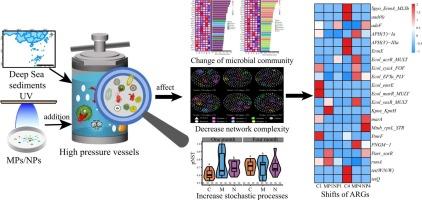Response of Sedimentary Microbial Community and Antibiotic Resistance Genes to Aged Micro(Nano)plastics Exposure under High Hydrostatic Pressure
IF 12.2
1区 环境科学与生态学
Q1 ENGINEERING, ENVIRONMENTAL
引用次数: 0
Abstract
Several studies reported that the presence of microplastics (MPs)/nanoplastics (NPs) in marine environments can alter microbial community and function. Yet, the impact of aged MPs/NPs on deep sea sedimentary ecosystems under high hydrostatic pressure remains insufficiently explored. Herein, the sedimentary microbial community composition, co-occurrence network, assembly, and transfer of antibiotic resistance genes (ARGs) in response to aged MPs/NPs were investigated. Compared with the control, NPs addition significantly reduced bacterial alpha diversity (p < 0.05), whereas MPs showed no significant impact (p > 0.05). Moreover, networks under NPs exhibited decreased complexity than that under MPs and the control, including edges, average degree, and the number of keystone. The assembly of the microbial community was primarily governed by stochastic processes, and aged MPs/NPs increased the importance of stochastic processes. Moreover, exposure to MPs/NPs for one month decreased the abundance of antibiotic resistance genes (ARGs) (from 94.8 to 36.2 TPM), while exposure for four months increased the abundance (from 40.6 to 88.1 TPM), and the shift of ARGs in sediment was driven by both functional modules and microbial community. This study is crucial for understanding the stress imposed by aged MPs/NPs on sedimentary ecosystems under high hydrostatic pressure.

沉积微生物群落和抗生素耐药性基因对高静水压下老化微(纳米)塑料暴露的响应
一些研究报告指出,海洋环境中存在的微塑料(MPs)/纳米塑料(NPs)会改变微生物群落和功能。然而,在高静水压条件下,老化的MPs/NPs对深海沉积生态系统的影响仍未得到充分探讨。本文研究了老化 MPs/NPs 对沉积微生物群落组成、共生网络、组装和抗生素抗性基因(ARGs)转移的影响。与对照组相比,NPs的添加明显降低了细菌的α多样性(p <0.05),而MPs则无明显影响(p >0.05)。此外,与 MPs 和对照组相比,NPs 作用下的网络在边缘、平均度和基石数量等方面的复杂性都有所降低。微生物群落的组装主要由随机过程控制,而老化的 MPs/NPs 增加了随机过程的重要性。此外,暴露于 MPs/NPs 中一个月会降低抗生素耐药基因(ARGs)的丰度(从 94.8 TPM 降至 36.2 TPM),而暴露于 MPs/NPs 中四个月则会提高抗生素耐药基因的丰度(从 40.6 TPM 升至 88.1 TPM)。这项研究对于了解高静水压力下老化MPs/NPs对沉积生态系统造成的压力至关重要。
本文章由计算机程序翻译,如有差异,请以英文原文为准。
求助全文
约1分钟内获得全文
求助全文
来源期刊

Journal of Hazardous Materials
工程技术-工程:环境
CiteScore
25.40
自引率
5.90%
发文量
3059
审稿时长
58 days
期刊介绍:
The Journal of Hazardous Materials serves as a global platform for promoting cutting-edge research in the field of Environmental Science and Engineering. Our publication features a wide range of articles, including full-length research papers, review articles, and perspectives, with the aim of enhancing our understanding of the dangers and risks associated with various materials concerning public health and the environment. It is important to note that the term "environmental contaminants" refers specifically to substances that pose hazardous effects through contamination, while excluding those that do not have such impacts on the environment or human health. Moreover, we emphasize the distinction between wastes and hazardous materials in order to provide further clarity on the scope of the journal. We have a keen interest in exploring specific compounds and microbial agents that have adverse effects on the environment.
 求助内容:
求助内容: 应助结果提醒方式:
应助结果提醒方式:


